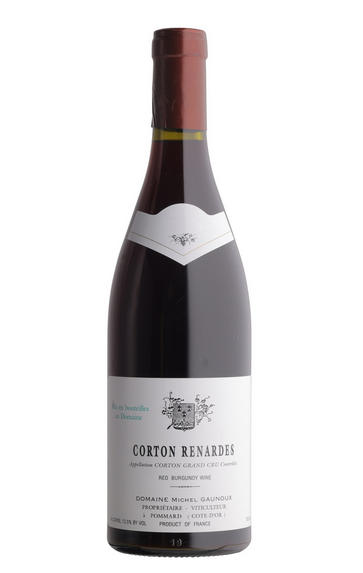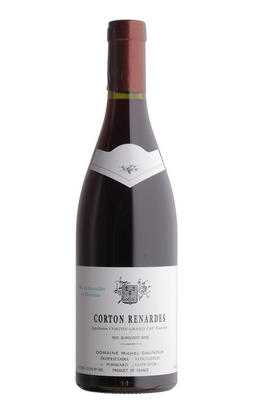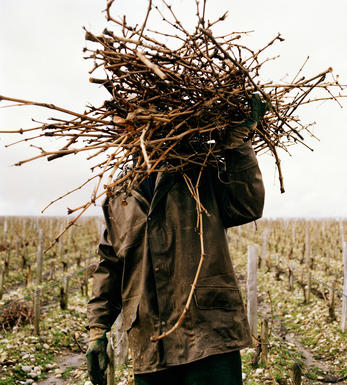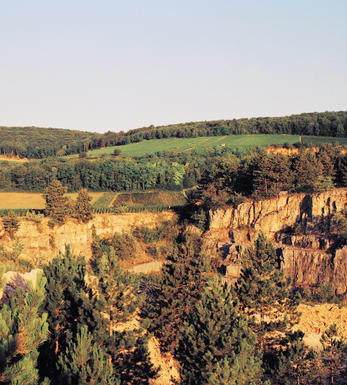
2018 Corton, Renardes, Grand Cru, Domaine Michel Gaunoux, Burgundy

Critics reviews
Like the Bourgogne, there is a mentholated element to the ripe aromas of poached plum and a mix of various red and dark cherry scents that convey a whisper of the Sauvage.
The highly seductive, indeed suave medium, weight plus flavours envelop the palate with sappy dry extract that does a fine job of buffering the very firm tannic spine shaping the wonderfully long, dusty, austere and lengthy finish that also displays just a barely perceptible trace of warmth.
Lovely stuff, and in contrast to several of the preceding wines, this could be reasonably approached after 7 to 8 years though it should repay up to twenty.
Drink from 2034 onward
Allen Meadows, Burghound.com (April 2021)
About this WINE

Domaine Michel Gaunoux
Located in the commune of Pommard, Burgundy, Domaine Michel Gaunoux is known for producing high-quality Pinot Noir wines. The Gaunoux family has been involved in winemaking for several generations, and they are highly respected for their traditional winemaking practices and commitment to producing exceptional wines that reflect the region’s terroir.
Michel Gaunoux founded the estate, and has been passed down through the family over the years. His descendants now manage it and continue the family’s winemaking legacy. They own several plots of vineyards in Pommard and some holdings in nearby appellations such as Volnay and Beaune.
The domaine’s primary focus is the production of red wines made from the Pinot Noir grape variety, the dominant grape in Burgundy. Pinot Noir from this region is known for its elegance, complexity, and ability to express the nuances of the soil and climate.
The estate is known for its traditional winemaking methods, with great attention to detail and a minimal intervention approach. They often use old oak barrels to age their wines, allowing the fruit and terroir to be at the forefront.

Aloxe Corton
These two Grand Cru vineyards, Corton and Corton-Charlemagne, lie astride three villages at the northern end of the Côte de Beaune: Ladoix, Aloxe-Corton and Pernand-Vergelesses. The main body of the hill of Corton faces due south, with an extended flank exposed to the east, and another facing westwards. The white wines mostly come from west and south-west expositions, along with a narrow band around the top of the hill.
The Emperor Charlemagne owned vines here in the eighth century, and legend has it that his wife insisted he planted white grapes so as not to spill red wine down his beard and clothes. Corton-Charlemagne is always white and there is also a theoretical Grand Cru appellation called, simply, Charlemagne, which is never used. Corton is almost entirely red but there are a few white wines too.Ladoix is a rarely-seen appellation, as most wine here are sold as Côte de Beaune Villages. Aloxe-Corton is better-known, but as with Ladoix the best vineyards have been designated as Corton and Corton-Charlemagne.
There are also 25 lieux-dits that may be used on wine labels, together with Corton: Les Bressandes, Les Chaumes, Clos des Meix, Clos du Roi, Les Combes, Le Corton, Les Fiètres, Les Grèves, Les Manguettes, Les Maréchaudes, Le Meix Lallemand, Les Paulands, Les Perrières, Les Pougets (Pougeots), Les Renardes, La Vigne au Saint, Les Basses Mourottes, Les Carrières, Clos des Cortons Faiveley, Les Grandes Lolières, Le Rognet et Corton, La Toppe au Vert and Les Vergennes.
- 90 hectares of village Aloxe-Corton
- 38 hectares of Premier Cru Aloxe-Corton
- 118 hectares of village Ladoix
- 14 hectares of Premier Cru Ladoix
- 72 hectares of Corton-Charlemagne. The finest from En Charlemagne (Pernand) and Le Charlemagne (Aloxe)
- 160 hectares of Corton. The best from Clos du Roi, Bressandes, Pougets

Pinot Noir
Pinot Noir is probably the most frustrating, and at times infuriating, wine grape in the world. However when it is successful, it can produce some of the most sublime wines known to man. This thin-skinned grape which grows in small, tight bunches performs well on well-drained, deepish limestone based subsoils as are found on Burgundy's Côte d'Or.
Pinot Noir is more susceptible than other varieties to over cropping - concentration and varietal character disappear rapidly if yields are excessive and yields as little as 25hl/ha are the norm for some climats of the Côte d`Or.
Because of the thinness of the skins, Pinot Noir wines are lighter in colour, body and tannins. However the best wines have grip, complexity and an intensity of fruit seldom found in wine from other grapes. Young Pinot Noir can smell almost sweet, redolent with freshly crushed raspberries, cherries and redcurrants. When mature, the best wines develop a sensuous, silky mouth feel with the fruit flavours deepening and gamey "sous-bois" nuances emerging.
The best examples are still found in Burgundy, although Pinot Noir`s key role in Champagne should not be forgotten. It is grown throughout the world with notable success in the Carneros and Russian River Valley districts of California, and the Martinborough and Central Otago regions of New Zealand.


Buying options
Add to wishlist
Description
Like the Bourgogne, there is a mentholated element to the ripe aromas of poached plum and a mix of various red and dark cherry scents that convey a whisper of the Sauvage.
The highly seductive, indeed suave medium, weight plus flavours envelop the palate with sappy dry extract that does a fine job of buffering the very firm tannic spine shaping the wonderfully long, dusty, austere and lengthy finish that also displays just a barely perceptible trace of warmth.
Lovely stuff, and in contrast to several of the preceding wines, this could be reasonably approached after 7 to 8 years though it should repay up to twenty.
Drink from 2034 onward
Allen Meadows, Burghound.com (April 2021)
wine at a glance
Delivery and quality guarantee